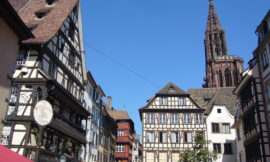Nestled in the picturesque Moselle Valley, Trier stands as a living testament to Germany’s rich historical tapestry. As the country’s oldest city, Trier boasts a captivating blend of Roman antiquity, medieval charm, and modern vitality. Known as Augusta Treverorum during the Roman Empire, Trier’s streets whisper stories of emperors, architects, and the echoes of a bygone era.
The Roman influence in Trier is most palpable in its UNESCO World Heritage Sites, which include some of the best-preserved Roman structures outside of Rome itself. The Porta Nigra, a massive stone gate that once served as the northern entrance to the city, is a formidable testament to Roman engineering. Originally part of the city’s defensive walls, the Porta Nigra’s darkened stone facade is a striking example of the enduring legacy of Roman architecture.
Another jewel of Trier’s Roman legacy is the Amphitheater, where gladiators once entertained the citizens of Augusta Treverorum. The grandeur of this ancient arena is still evident in its well-preserved walls and the arena floor, providing a glimpse into the spectacle that unfolded here nearly two millennia ago.
The Basilica of Constantine, also known as the Aula Palatina, is yet another marvel from Trier’s Roman past. Originally built as a throne room for the Roman Emperor Constantine, this vast hall with its red brick walls and soaring architecture now serves as a Protestant church. The juxtaposition of its historical significance and contemporary function reflects the city’s ability to seamlessly integrate the old and the new.
Trier’s Roman heritage extends to the Imperial Baths, where Romans once gathered for leisure and relaxation. The extensive ruins reveal the intricate engineering behind Roman bathhouses, showcasing a level of sophistication that characterized Augusta Treverorum during its heyday.
The Cathedral of Trier, or Trierer Dom, adds a medieval touch to the city’s architectural ensemble. With its mix of Romanesque, Gothic, and Baroque elements, the cathedral stands as a testament to Trier’s evolution through the centuries. The cathedral’s stunning interiors house the Holy Tunic, believed to be the seamless garment worn by Jesus Christ during his crucifixion, making it a significant pilgrimage site.
The Electoral Palace, a grand Rococo residence, offers a glimpse into Trier’s more recent history. Built in the 18th century, the palace served as the residence of the Prince-Electors of Trier and is now home to the Rheinisches Landesmuseum, showcasing the region’s cultural and historical treasures.
Trier’s vibrant town center, with its cobbled streets and charming squares, provides a delightful backdrop for exploring the city. The Hauptmarkt, or Main Market Square, is surrounded by colorful facades and is home to the iconic Market Cross. The square is a lively hub, hosting markets, festivals, and events that bring locals and visitors together.
In addition to its historical riches, Trier is surrounded by the scenic landscapes of the Moselle Valley. The vineyards that blanket the hillsides produce some of Germany’s finest wines, and a leisurely stroll along the Moselle River offers breathtaking views of the city and its surroundings.
In conclusion, Trier is a city that unfolds like a chronicle of time, each cobblestone telling a story of Roman splendor, medieval glory, and modern vitality. It is a place where the past is not confined to museums but is intricately woven into the fabric of daily life. Trier invites visitors to step into its streets and traverse the corridors of history, where emperors once walked, and where the echoes of a rich and diverse heritage resonate through the ages.



